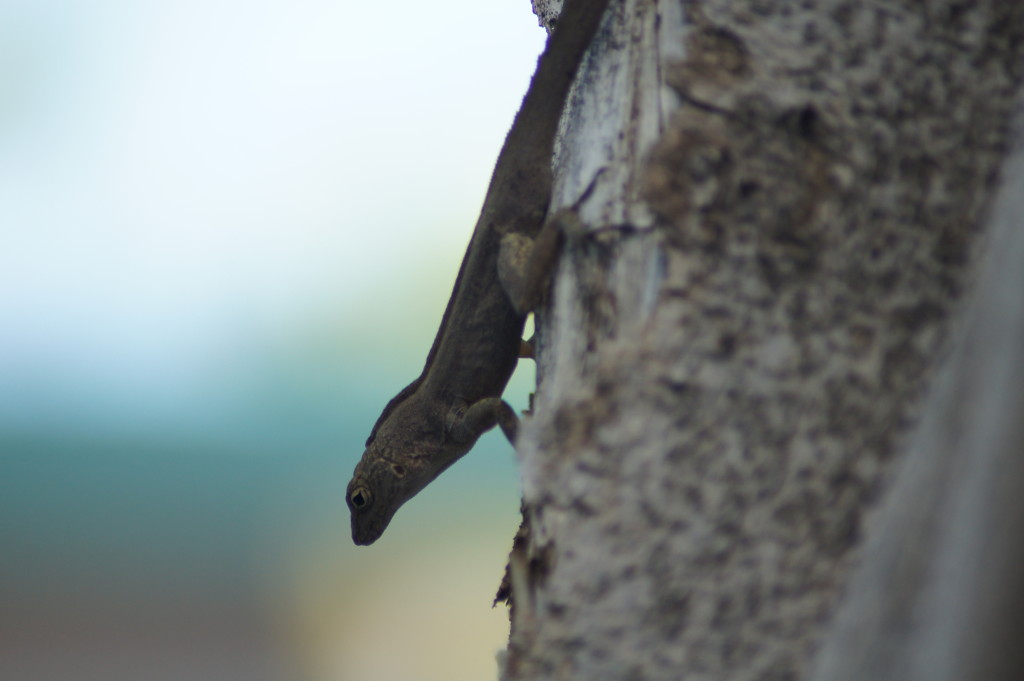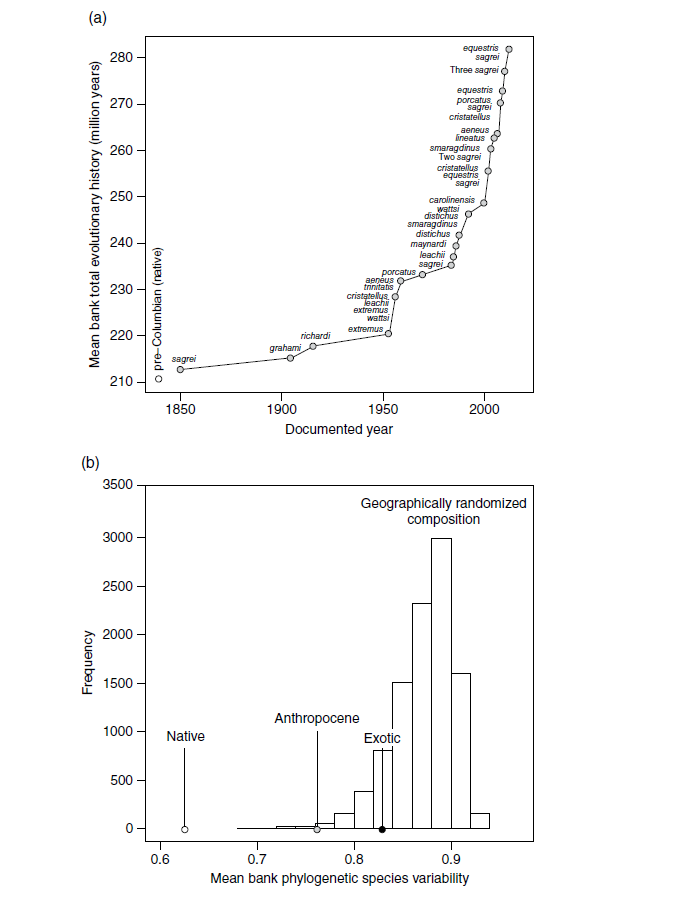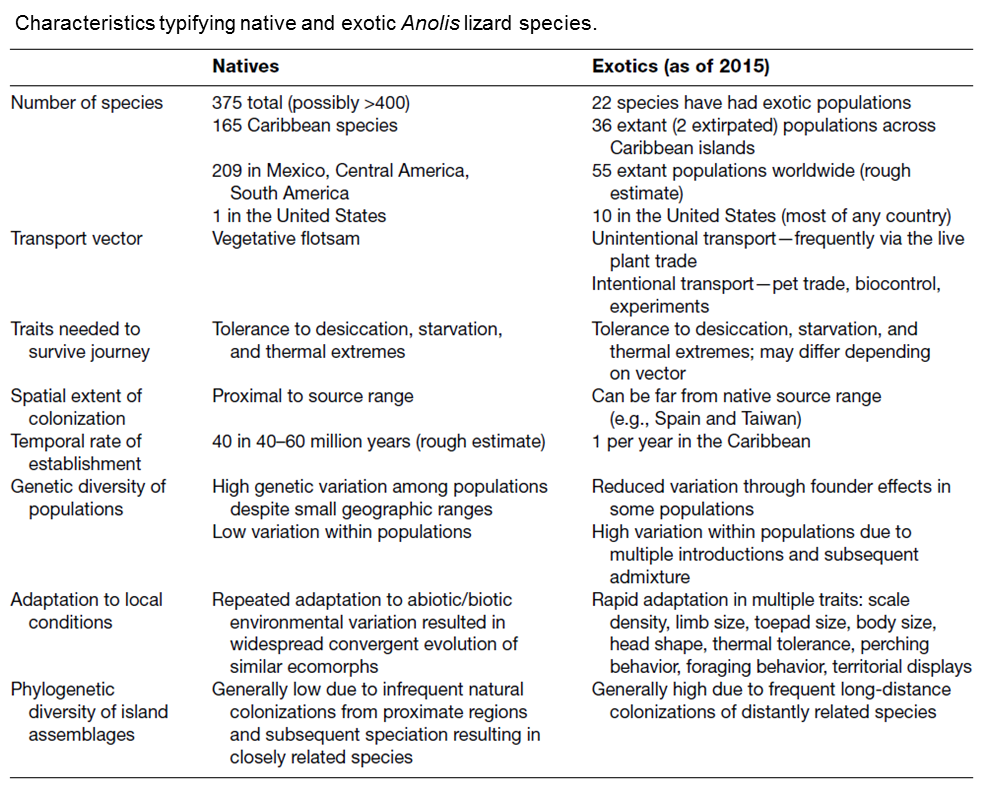

| Online: | |
| Visits: | |
| Stories: |
Spot the Differences: Native vs. Exotic Anoles
Recently, the book Invasion Genetics: the Baker & Stebbins legacy was published online, covering various aspects of the evolutionary biology of invasive plant, animal, fungus and microbe species. One chapter, coauthored by myself, will particularly appeal to Anole Annals readers, as it provides an extensive review of the genetic, evolutionary and ecological differences between exotic and native anole species. Anoles are highly appropriate for a book on invasion genetics, because of the large body of research on both the genotype and phenotype of anoles, the many species that have exhibited the ability to establish populations outside of their native range, and the exponentially increasing number of exotic anole populations since the onset and intensification of travel and trade in the Caribbean and across the world.
The chapter contrasts what is known about the natural dispersal and colonization processes of Caribbean native anoles to the human‐mediated translocation of exotic anoles in the Anthropocene. Previously, natural colonization events rarely occurred, whereas the rate of new (exotic) anole colonizations has increased drastically. The main argument of the chapter is that the many exotic introductions have eroded the previously strong biogeographic structure of anole assemblages.

An exotic crested anole male (Anolis cristatellus) on the island of St. Martin. (photographer: Wendy Jesse)
In the past, anoles on Caribbean islands tended to have high genetic spatial structure and the species found on islands tended to be more closely related to each other than to species on other islands. This meant that anole populations had low genetic diversity within populations, but high diversity among populations. Similarly, anole island assemblages had low within-assemblage phylogenetic diversity and high among-island assemblage phylogenetic diversity. Today those natural patterns are disappearing. Exotic anole populations have higher genetic diversity than native populations due to multiple (cryptic) colonizations of the same species to an exotic location (Kolbe et al. 2004, 2007). Furthermore, anole assemblages are increasingly gaining phylogenetic diversity and becoming more phylogenetically random (i.e., less phylogenetically clustered) because species from clades once separated by long geographic distances are now connected by economic trade (see the figure).

Caribbean anole phylogenetic diversity is increasing in the Anthropocene. (a) The total evolutionary history of anoles on Caribbean banks has increased on average by approximately 25% since pre‐Columbian times. Points are the mean phylogenetic diversity across all Caribbean banks for a given year. Labels indicate the species that were introduced each year. (b) Native phylogenetic species variability (average relatedness of anole species on a bank) is significantly less than expected if species randomly colonized banks regardless of geographic location (null-model histogram) (P ≪ 0.001), while exotic anole phylogenetic composition is not (P > 0.05). In the Anthropocene, overall island bank composition (natives and exotics combined) is becoming less geographically structured, but still significant (P < 0.01). (source: Helmus et al. 2016)
The chapter also reviews all stages of the invasion process, from transportation to adaptation. For every stage, we again compare native to exotic species and identify similarities and differences between species with and without established exotic populations (see the table). In addition, effects of invasions on species interactions are discussed, and the final portion of the chapter is reserved for prospects into the future evolution of anoles under intensifying scenarios of human impact.
References:
Helmus, M.R., Behm, J.E., Jesse, W.A., Kolbe, J.J., Ellers, J. & Losos, J.B. (2016). Exotics exhibit more evolutionary history than natives: A comparison of the ecology and evolution of exotic and native anole lizards. Pp. 122-138 in S.C. H. Barrett, R.I. Colautti, K.M.. Dlugosch, and L.H. Rieseberg, Eds., Invasion Genetics: The Baker and Stebbins Legacy. John Wiley & Sons.
Kolbe, J.J., Glor, R.E., Rodriguez Schettino, L., Lara, A.C., Larson, A. & Losos, J.B. (2004). Genetic variation increases during biological invasion by a Cuban lizard. Nature, 431, 177
Kolbe, J.J., Glor, R.E., Schettino, L.R., Lara, A.C., Larson, A. & Losos, J.B. (2007). Multiple sources, admixture, and genetic variation in introduced Anolis lizard populations. Conserv. Biol., 21, 1612–1625
Source: http://www.anoleannals.org/2016/11/08/spot-the-differences-native-vs-exotic-anoles/




